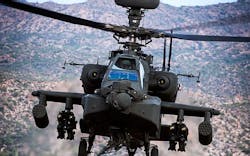Boeing to build 24 Apache attack helicopters for Qatar under terms of $667.5 million contract
Officials of the Boeing Defense, Space & Security segment in Mesa, Ariz., will provide 24 AH-64E Apache Guardian attack helicopters, helicopter avionics, Thales radios, ground-support equipment, and one crew trainer under terms of the foreign military sales (FMS) contract from the Army Contracting Command at Redstone Arsenal, Ala.
The AH-64 Apache is a multirole combat helicopter with integrated avionics and weapons, as well as advanced digital communications to enable real-time, secure transfer of battlefield information to air and ground forces.
The E-model Apache Guardian features enhanced performance, joint digital operability, improved survivability and cognitive decision aiding, and reduced operating and support costs, Boeing officials say. The AH-64E Apache, is being delivered to the U.S. Army and has been selected by several international defense forces.
The AH-64E has the AN/APG-78 millimeter wave fire-control radar, radar frequency interferometer, fire-and-forget radar-guided Hellfire missile capability, and cockpit management and digitization enhancements.
This military helicopter also has the Lockheed Martin Apache Arrowhead Modernized Target Acquisition Designation Sight (M-TADS) and Pilot Night Vision Sensors (PNVS) systems.
Formerly known as AH-64D Block III, the AH-64E Guardian has improved digital connectivity, the joint tactical radio system (JTRS), more powerful T700-GE-701D engines with upgraded transmission to accommodate more power, capability to control unmanned aerial vehicles (UAVs), new composite rotor blades, instrument flight rules (IFR) capability, and improved landing gear.
The AH-64E is designed to conduct armed reconnaissance, close combat, mobile strike, and vertical maneuver missions in day, night, obscured-battlefield, and adverse-weather conditions. The helicopter has self-diagnostic abilities, Link-16 data linking, and updated Longbow radar with oversea capacity that could enable naval strikes.
Versions of the AH-64 Apache attack helicopter have been in service with the U.S. Army since 1986. It is a four-blade, twin-engine attack helicopter with a tandem cockpit for a two-man crew.
It has a nose-mounted sensor suite for target acquisition and night vision systems. It is armed with a 30-millimeter M230 Chain Gun carried between the main landing gear, under the aircraft's forward fuselage.
It has four hardpoints mounted on stub-wing pylons, typically carrying a mixture of AGM-114 Hellfire missiles and rockets. The helicopter was designed to replace the Bell AH-1 Cobra as the Army's primary attack helicopter. The U.S. Marine Corps still operates late-model versions of the AH-1 Cobra.
On this contract, Boeing will do the work in Mesa, Ariz., and should be finished by May 2020. For more information contact Boeing Defense, Space & Security online at www.boeing.com/defense, or the Army Contracting Command at Redstone Arsenal at www.acc.army.mil/contractingcenters/acc-rsa.
